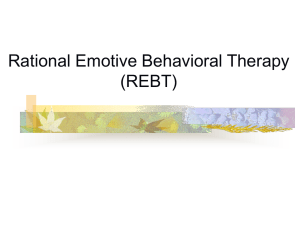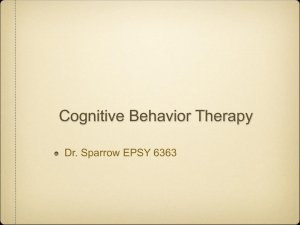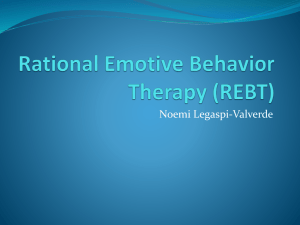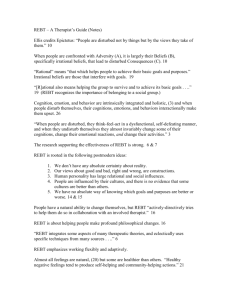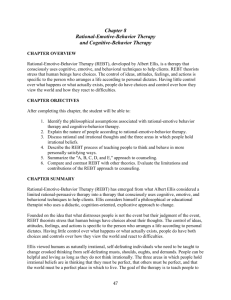File - Charity Hays, MSSC
advertisement
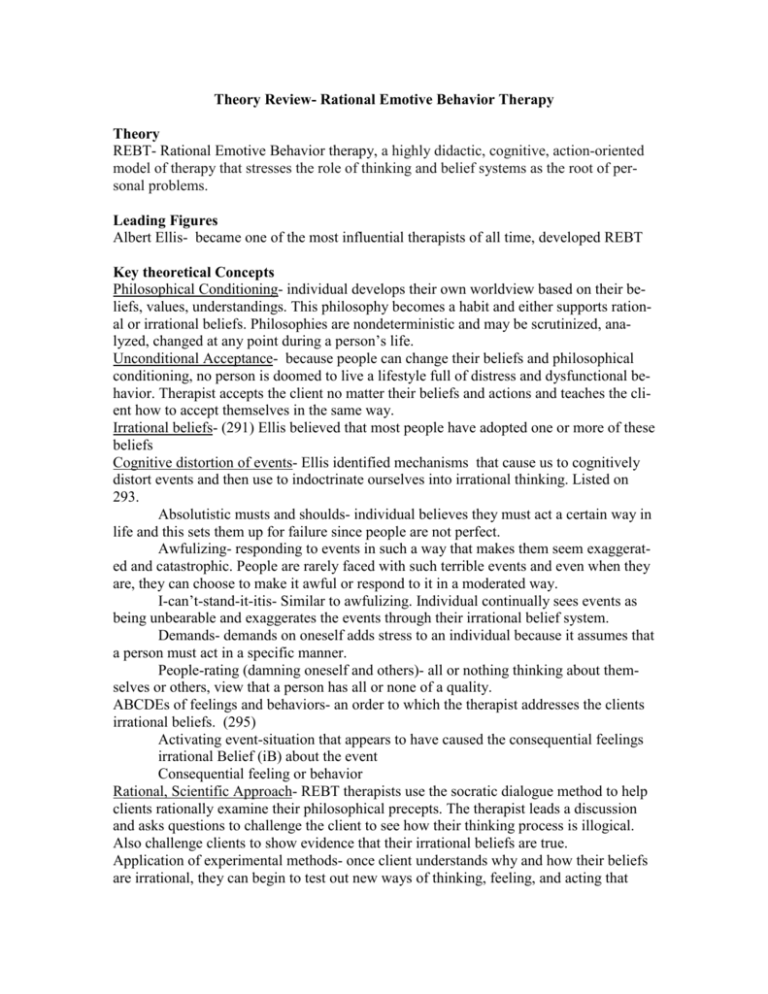
Theory Review- Rational Emotive Behavior Therapy Theory REBT- Rational Emotive Behavior therapy, a highly didactic, cognitive, action-oriented model of therapy that stresses the role of thinking and belief systems as the root of personal problems. Leading Figures Albert Ellis- became one of the most influential therapists of all time, developed REBT Key theoretical Concepts Philosophical Conditioning- individual develops their own worldview based on their beliefs, values, understandings. This philosophy becomes a habit and either supports rational or irrational beliefs. Philosophies are nondeterministic and may be scrutinized, analyzed, changed at any point during a person’s life. Unconditional Acceptance- because people can change their beliefs and philosophical conditioning, no person is doomed to live a lifestyle full of distress and dysfunctional behavior. Therapist accepts the client no matter their beliefs and actions and teaches the client how to accept themselves in the same way. Irrational beliefs- (291) Ellis believed that most people have adopted one or more of these beliefs Cognitive distortion of events- Ellis identified mechanisms that cause us to cognitively distort events and then use to indoctrinate ourselves into irrational thinking. Listed on 293. Absolutistic musts and shoulds- individual believes they must act a certain way in life and this sets them up for failure since people are not perfect. Awfulizing- responding to events in such a way that makes them seem exaggerated and catastrophic. People are rarely faced with such terrible events and even when they are, they can choose to make it awful or respond to it in a moderated way. I-can’t-stand-it-itis- Similar to awfulizing. Individual continually sees events as being unbearable and exaggerates the events through their irrational belief system. Demands- demands on oneself adds stress to an individual because it assumes that a person must act in a specific manner. People-rating (damning oneself and others)- all or nothing thinking about themselves or others, view that a person has all or none of a quality. ABCDEs of feelings and behaviors- an order to which the therapist addresses the clients irrational beliefs. (295) Activating event-situation that appears to have caused the consequential feelings irrational Belief (iB) about the event Consequential feeling or behavior Rational, Scientific Approach- REBT therapists use the socratic dialogue method to help clients rationally examine their philosophical precepts. The therapist leads a discussion and asks questions to challenge the client to see how their thinking process is illogical. Also challenge clients to show evidence that their irrational beliefs are true. Application of experimental methods- once client understands why and how their beliefs are irrational, they can begin to test out new ways of thinking, feeling, and acting that will lead them to healthier lifestyle. The therapist can teach the client about new, rational ways of thinking. Key Techniques REBT is psychoeducational- it teaches the client more effective ways of living in the world and about their psychological self. Showing unconditional acceptance- therapist shows client acceptance and realization that every person has done bad things that affect themselves and others but nobody is perfect and without fault. Teaching the REBT philosophy- teach the client about the philosophy of REBT and encourage clients to read books and other materials so they fully understand it. Being active and directive- therapist does listen to client but also asks questions, and gather information from client to assess the client to understand how they distort events and use irrational thinking. Challenging clients- not to be confused with major confrontation. Therapists should suggest that clients examine their current way of understanding or thinking. After this review of their beliefs, clients will hopefully chose new beliefs and behaviors. Demonstrating the ABDs- therapist will use these to show the client how their irrational beliefs are causing emotional distress, not the situation of activating event. Encouraging the disputing of dysfunctional cognitions, behaviors, and emotions- once client realizes how their actions and decisions have not been healthy, therapist encourages client to dispute the unhealthy ones (300) Cognitive Disputation- once clients realize it is their beliefs and not the event that causes problems, therapist has them dispute their irrational beliefs and counselor can suggest the irrational beliefs be replaced with new rational ones. Behavioral Disputation- helpful to practice behavioral changes that go alongside the cognitive changes. Encouraged to practice behaviors that challenge the irrational ones Emotive Disputations- rational-emotive imagery is most common. Therapist asks client to close their eyes and imagine the event that has caused them to think irrationally. Once they can picture the event and feel their anger rise, the signal to the therapist and will ask client to change their negative emotion to an appropriate one. Usually the client is able to change the way they would want to respond to the situation. Using humor- REBT therapists can sometimes see the humor of situations when individuals have taken on such irrational beliefs. Sometimes pointing out the humor of a situation can help the client see the pointlessness and irony of the situation. Using metaphors- metaphors and stories can sometimes be used to illustrate the therapists point. Homework- therapists actively encourage clients to practice new techniques at home to help maintain the new, more rational belief system. Role of therapist access the clients situations, understand their upsetness, and create a hypothesis as to how the client is cognitively distorting their events and causing distress. Before the therapist explains their hypothesis, they must make sure the client understand the REBT philosophy. Demonstrate how the clients situation fits the REBT model, direct the change process, and reinforce change and terminating the relationship are also step of the process. Goals to understand why the client comprehends things and acts in the specific, negative way that they do. Once the client understands how they react irrationally, steps are taken to change their behaviors and beliefs to live with a healthier view of life. What creates symptoms the way clients react to/view situations. They believe it is the event that causes their distress, but it is the way they view the event that causes problems. Conditions of Change The client needs to understand how they react to situations and have the desire to change the way they view things so that they are not bogged down by their irrational beliefs Personal Reactions Well I definitely agree that Ellis is a very interesting man, and I would imagine his theory would follow suit of his “personality”, if you will. I think teaching a philosophy to someone sounds exhausting. Even if it does give them the tools to internalize the change process and create a new reality, how do you really get the client to believe in the philosophy enough to internalize? Just a little skeptical of this one.
